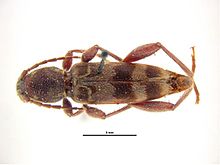
The Asian long-horned beetle, also known as the starry sky, sky beetle, or ALB, is native to the Korean Peninsula, northern and southern China, and disputably in northern Japan. This species has now been accidentally introduced into the eastern United States, where it was first discovered in 1996, as well as Canada, and several countries in Europe, including Austria, France, Germany, Italy and UK.

The longhorn beetles (Cerambycidae), also known as long-horned or longicorns, are a large family of beetles, with over 35,000 species described.

Bostrichoidea is a superfamily of beetles. It is the type superfamily of the infraorder Bostrichiformia.

Knulliana is a genus of longhorn beetles. It is monotypic, being represented by the single species Knulliana cincta, commonly known as the banded hickory borer. The species may be found throughout the eastern half of North America, including Mexico and the Bahamas, with one subspecies extending to the Sonoran Desert.

Xanthocryptus novozealandicus, the lemon tree borer parasite, is a wasp in the family Ichneumonidae. It is a native insect of New Zealand. It is also found in Australia and New Guinea. Females hunt for larvae of wood-boring beetles around March, including the lemon tree borer, a native cerambycid that tunnels into citrus trees, grapes and many native species. When a suitable host is found, the female pushes her ovipositor through the wood and injects her eggs into the grub. This has the incidental benefit of helping to control some pests. X. novozealandicus prefers to prey on second year lemon tree borer larvae. This specific parasite prefers to prey on larger second year larvae due to its larger size.

The Banded Alder Borer is a member of the very diverse family of longhorn beetles.

Neoclytus acuminatus, the red-headed ash borer, is a common North American species in the longhorn beetle family (Cerambycidae).

Xylotrechus a genus of longhorned beetles of the family Cerambycidae, containing some 200 described species.
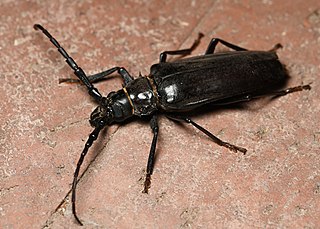
Derobrachus hovorei is a species of beetle in the family Cerambycidae, known variously as the palo verde beetle, palo verde root borer, or palo verde borer beetle. For over 100 years, this species was confused with the related species Derobrachus geminatus, and only recognized and given its own name by Santos-Silva in 2007; essentially all literature prior to 2007 therefore incorrectly uses the name geminatus for this species. It is a longhorn beetle native to the southwestern United States and northern Mexico which derives its common name from the palo verde tree, and it is one of the largest beetles in North America, reaching up to three and a half inches in length. Adults are black or brown in colour, have long antennae, and spines on the thorax. They have wings and can fly, albeit awkwardly at times. Mature beetles emerge in the summer to mate. While not harmful to humans, they can bite in self-defense.

Placosternus difficilis, commonly known as the mesquite borer, is a wood-boring longhorn beetle which resembles a black and yellow wasp. Larvae of mesquite borers are deposited in, among others, mesquite trees, although it has been recorded from a range of hosts and is considered polyphagous. It has been seen to be attracted to mesquite trees when there is freshly cut or broken limbs and logs. Adults use nectar and pollen as a food source.

Tragocephala variegata, the longhorn shoot borer, is a species of flat-faced longhorn beetles belonging to the family Cerambycidae.

Pachyteria dimidiata, the mimusop stem borer, is a species of round-necked longhorn beetle of the subfamily Cerambycinae.

Chlorophorus varius, the grape wood borer, is a species of beetle in the family Cerambycidae.

Neoclytus caprea is a species of beetle in the family Cerambycidae. It was described by Say in 1824. It feeds on sapwood of ash, sometimes oak, and hickory. It often emerges indoors from firewood; logs may become infested within 20 days of felling during summer. The banded ash borer experiences sexual dimorphism, as the female of the species is considerable larger in size than the male and has yellow and black elytra coloring rather than white and black of the male of the species. They produce one generation a year.

Xylotrechus insignis is a species of beetle in the family Cerambycidae. It was described by John Lawrence LeConte in 1873. Xylotrechus insignis is commonly referred to as a willow borer which means that it drills into trees usually killing or harming the tree. Xylotrechus insignis lives mainly in trees and especially willows; mainly in North America. They get to be about 12 to 16 mm long

Xylotrechus quadripes is a species of beetle in the family Cerambycidae. It was described by the French entomologist Auguste Chevrolat in 1863. In peninsular India, it is well known for its habit of boring through the stems of coffee plants in plantations and is considered a pest and known by the common name coffee white stem borer. Because the larvae damage the plant while being hidden inside the woody stems, it is extremely difficult to control. The control of shade over the coffee bushes however reduces the incidence.
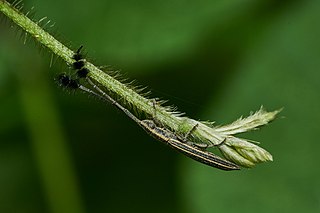
A stemborer is any insect larva, or arthropod, that bores into plant stems. However the term most frequently refers among the Coleoptera to the larva of certain longhorn beetles such as Dorysthenes buqueti and those of the genus Oberea, and among the Lepidoptera to certain moths of the Crambidae, Castniidae, Gelechiidae, Nolidae, and Pyralidae families.
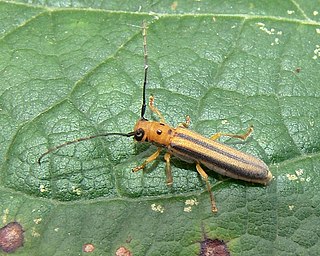
Oberea tripunctata, the dogwood twig borer, is a species of longhorn beetle that is a widespread pest that attacks dogwood trees.
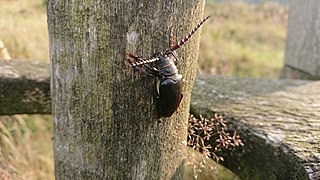
Prionus laticollis, also known as the broad-necked root borer or broad necked prionus, is a root-boring longhorn beetle described by Dru Drury in 1773. It is widespread throughout eastern North America: its range covers a vast swath from Quebec in the northeast to Arkansas in the southwest.

Twig borer refers to a number of species of beetles and moths that chew holes into small branches of trees and shrubs. Many of these insects are agricultural pests. Animals that are called twig borers include:
